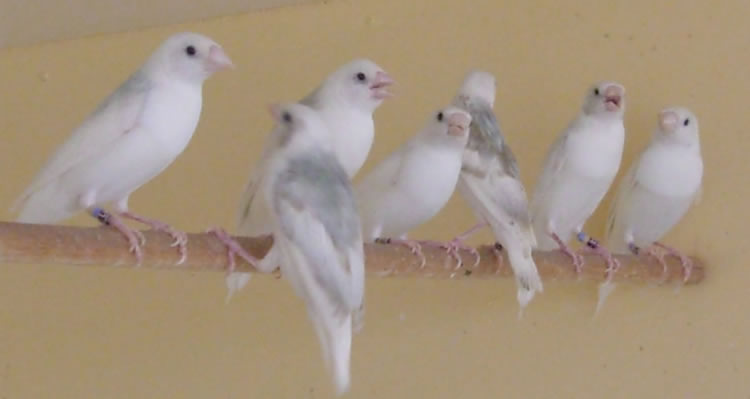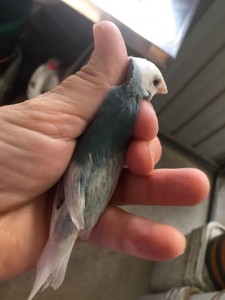Karen and Les, passionate breeders of the Australian Gouldian have just announced some exciting news in their quest to improve a formerly genetically weak line of mutation.
Read on to learn about the Aussie Variegated Blue…
———————————
Aussie Variegated Blue (AVB)
We take this opportunity to share our experiences of the Aussie Variegated Blue as pictured.
This bird is recessive in genetic makeup resulting from the crossing of the Australian Yellow and the European Blue. This bird has appeared from two existing mutations, resulting in it being a secondary mutation. The word “variegated” is applied to this bird as its back colour varies from light to heavy and in some birds almost disappears with age. In our experiences, the back colour of hens tends to be light to heavy greyish blue, with the cocks expressing the same degrees in variance but more blue in colour. This however is not a way of determining their sex. With the ground colour of the bird being white, it results in a very attractive bird. As with the Australian Yellow a clear white chest is preferred and obtained through selective breeding.


The term variegated means a clear bird showing any form or melanistic markings on its feathers from a tick to three parts dark (adopted and revised by SCCA 1995 from the earlier versions done by the Stafford Canary Club in England).
This bird was first sighted in the mid 90’s resulting from the cross of split Blues and split Australian Yellow birds. These birds were housed and bred together for the purpose of fostering eggs from the early Blue mutation. As the above named bird was of a weak genetic structure, no young were obtained.
These birds have since been produced in strong genetic quality using full blood Australian Yellow and European Blues, by crossing the resulting offspring over four generations, resulting in the breeding and establishment of this bird. In the beginning there were opinions that these birds were infertile, however our records show quite the opposite, as they are very good breeders and parents.
Using the pairing of Blue split Australian Yellow with an Australian Yellow split Blue we obtained the following results, with numbers of Aussie Variegated Blues being approximately one in four:
- Aussie Variegated Blue
- Blue split Australian Yellow
- Australian Yellow split Blue
- Normal split Blue split Australian Yellow (Double splits)
Other pairings weren’t as reliable and produced a lot of “possibles”. For example, an Australian Yellow split Blue over a Double Split (split Blue/split Australian Yellow), produced:
- Aussie Variegated Blue (though in small numbers)
- Blue split Australian Yellow
- Australian Yellow possibly split Blue
- Normal split Australian Yellow possibly split Blue
Breeding double splits together created even more “possibles”!
Although the above two pairings have produced some quality Aussie Variegated Blues, we no longer pursue these combinations due to the too many unknowns.
In more recent years we have paired the Aussie Variegated Blue over pure normal and white breasted normal to produce split Aussie Variegated Blues. This also introduces fresh bloodlines which is imperative to maintaining genetically strong birds. Pairing these splits back across Aussie Variegated Blues has to date, substantially increased the numbers of Aussie Variegated Blues in the nest, with one particular nest recently producing four Aussie Variegated Blues and two Australian Yellow split Aussie Variegated Blue. It also produces, though in smaller numbers:
- Blue split Aussie Variegated Blue
- Split Aussie Variegated Blue which appear as normal
Through all of the above pairings we have noted that in some instances Blue birds that are split to Australian Yellow or Aussie Variegated Blue show “tell-tale” flecks of colour, often a white spot under the beak or white fleck/s on the back of the neck. Normal looking birds that are split to either may also show a white spot under the beak but have flecks of yellow on the back of the neck. We have also noted heavy patching on the cheeks of some Aussie Variegated Blues. Some refer to this as a colour imperfection or pied, but it doesn’t always appear and it does assist in identifying birds that have been bred using double splits.
Worth noting also is the size and overall quality of the birds produced from these pairings, with some very strong, robust birds of very good size and conformation being produced.
We now have quite a few of these Aussie Variegated Blues breeding and successfully rearing their own young, which indicates the methods adopted in breeding this bird are conclusive.

As with any quest to establish a new mutation (in this case a secondary mutation), it is a labour of love and one we have immensely enjoyed! Although still early days we look forward to establishing this bird as an addition to the many beautiful colours currently available, and of course, we also look forward to the next challenge!!
Karen – Geelong, Victoria
Les – Deniliquin, NSW
———————————
I have been asked to make comment and I am more than happy to do so relating to the new mutation, the Aussie Variegated Blue! I am the original breeder of the Australian Yellow and I have also been the biggest critic of any secondary mutation that has been combined with the European Blue. My reasoning is that in past attempts when using the blue it has done nothing but contaminate and weaken the bird that it has been combined with.
Well Karen and Les obviously have had the same thoughts, regarding the European Blue and have approached the development of this new mutation as a long term and serious project over many years for the satisfaction of developing a quality bird, not for the monetary gain but for the personal achievement of producing a quality mutation.
Based on my vast experience and research of G.B.R. Walker, I would also like to make comment on how to develop good heavily coloured variegated birds for future breeders to understand how variegation works.
Whether or not a bird expresses melanin has nothing to do with the colour genes. The manifestation of the melanin pattern is determined by another set of genes called “variegation factors” Certain areas of the body of the bird are more receptive to the deposit of melanin. These are the crown of the head, the eyes and cheek, breast, flank, wings, outer tail feathers and the back. The pattern of melanin deposit is partly controlled by one of two variegation factors, and this is the major one. The second variegation factor is responsible for the depth of colouration of the melanins. The closer one gets to producing a clear bird, the further one is departing from the variegated.
Don Crawford
www.australiangouldian.com